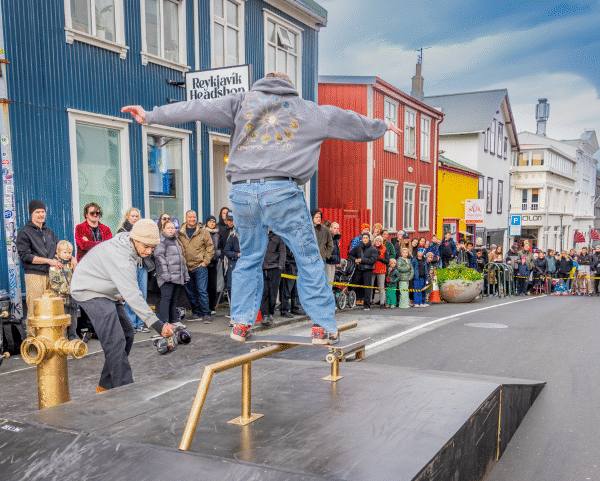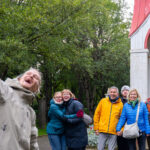Icelandic Literary Heritage
This blog is written by Einar Steinn, one of Your Friend in Reykjavik‘s guides. A dedicated book lover with an impressive knowledge of Icelandic literature, Einar brings a wealth of insight into Iceland’s storytelling traditions. Born and raised in Reykjavík, he’s a guide, skilled tourism writer, and translator.
For a chance to meet Einar when you’re in Iceland, join our Reykjavik Folklore Tour or Walk With a Viking Tour.
Read other blogs on Icelandic literature:
The Icelandic Sagas for Beginners
Recommended Reads from Iceland
Norse Mythology and Icelandic Folktales Inspired Tolkien
Icelanders have a long and proud literary heritage and their Icelandic authors dating back to the Middle Ages. That’s when classic works of literature, the Icelandic sagas and the two Eddas, were written about heroes from the Viking Age and Norse mythology. Nowadays, hundreds of new titles get published yearly in Iceland, which is no small feat for a small market in a country of less than 400.000 people. I myself have been an avid book dragon (why be a worm when you can be a dragon?) ever since I was little, and in this blog series, I’d like to share with you some writers and works that have been translated into English and which I recommend.
Jón Gnarr
Ásta Sigurðardóttir
Halldór Laxness
Gerður Kristný
Þórbergur Þórðarson
Ewa Marcinek
Jón Gnarr (b. 1967)

Jón Gnarr is best known in Iceland as a comedian, writer, and sometimes politician. He and Sigurjón Kjartansson form the comedy duo Tvíhöfði (Double-Head) and have been active in radio and television since the 1990s. Jón was also part of the classic sketch comedy group Fóstbræður (Blood Brothers) and the leading role in the hit tv series Næturvaktin/Dagvaktin/Fangavaktin (The Nightwatch/Daywatch/Prisoner Watch) and its film sequel Bjarnfreðarson.
Jón ran for mayor of Reykjavík in 2009 on a satirical campaign but ended up being elected. Many saw this as a reaction to Iceland’s economic turmoil at the time, the 2008 bank crash, and the 2008-2009 protests, thus reflecting a disillusionment with traditional politicians and politics.
Four of Jón’s books have been translated into English. His account of his campaign and term as mayor; and his autobiographical novel trilogy; The Indian; The Pirate; and The Outlaw. Of these I’ve read The Pirate and heartily recommend it.
The Pirate

Jón had a hard time growing up in the 1970s and 80s, he was misdiagnosed with severe intellectual disability as a child, and treated from the age of 5-7 at a children’s psychiatry ward. He was later correctly diagnosed with dyslexia and ADHD and had learning disabilities in school. He found himself an outsider, didn’t fit in the system and was teased and bullied. And he was a redhead.
As a teenager he sought solace and companionship in punk (he became known as Jónsi Punk) and played in punk band Nefrennsli (they had one gig which fell into chaos because of Jón’s stage fright). He describes all this in a tragicomic manner in the book, such as his love for- and heartbreak towards Nina Hagen. He’d seen a photo of Nina and found her hot but then listened to her music, and could only gather that she wanted to go to Africa, but didn’t seem to be interested at all in anarchism or toppling the system.
Hlemmur Bus Station – Refuge for Outcasts
One of the most moving things about the book is the sympathetic way Jón describes the “Hlemmur”-punk kids who used to hang out at the Hlemmur bus station in Reykjavík. They were generally outsiders and outcasts, often from broken homes, and had largely been shunned and judged as troubled and good-for-nothing by society, but found solidarity and comfort in each other’s company.
The punks at Hlemmur have now mostly become grown adults. Some have done alright and even found happiness in life, like myself. But many of these kids are dead. One good friend of mine died from a drug overdose in a foreign city. Another leapt into the sea and drowned in a drug-fueled haze. Another was killed. In my memory they are still only thirteen years old, small and confused, baby-faced and in leather-jackets.
That love exists at all in this world is a miracle because if everything had gone according to plan, the brutal world would have long since killed it off.
– Jón Gnarr, The Outlaw. English translation: Lytton Smith.
Ásta Sigurðardóttir

Ásta Sigurðardóttir was one of the most talented Icelandic authors of her generation. However, her writings and lifestyle scandalised many, and she lived a tragic life.
Born in Snæfellsnes in West Iceland in 1930, she moved to Reykjavík when she was 14 years old and published her first and most famous story at 21. As well as being a writer of short stories and poems, she was a fine artist, be it pottery, paintings or woodcuts and she illustrated her stories herself.
Ásta was a leading member of a circle of bohemian poets called atómskáld (the atom poets) and in her writings and lifestyle she both broke taboos and went against what was widely considered appropriate behaviour for women at the time, challenging as she did accepted morals and propriety in the small community of Reykjavík at the time.
Ásta Wrote About the Underdogs
She had a striking appearance and to support herself modelled for artists and posed naked in stylized glamorous photos, sporting red lipstick, pitch-black hair and smoking a cigarette, giving her an air of mystique and a femme fatale image. This belied her tragic reality. Ásta wrote, often autobiographically, about the underside of Icelandic society, about underdogs, the disempowered, the disenfranchised, societal loners and outcasts, about violence towards women and children, about promiscuity, miscarriage and abortion, about poverty, substance abuse and addiction and about chauvinism and prejudice.
Her imagery was powerful, and her writings showcase a talented, sensitive and earnest writer with a strong sense of justice. And throughout the work there is a desire for acceptance in a society more inclined to condemn her. In her own life Ásta struggled with poverty, homelessness, social prejudice, losing custody of her children, and alcohol addiction. She passed away from complications of alcohol abuse at only 41 years old.
Sunday Night to Monday Morning
Ásta’s most famous story, From Sunday Night to Monday Morning, describes a young woman’s night out, an assault she faces and her own and society’s reaction. Society judges her and, as is not uncommon with survivors of abuse, the narrator also deals with self-doubt and self-accusations.
The story was based on an assault Ásta herself suffered, and just as art reflected reality, reality reflected the art back, because while the story met with praise from many in the literary circle, it also scandalised many in the general society and filled them with prejudice towards the author. It is strange for a modern reader to think that many saw the story as tantalising or titillating, whereas today it is widely hailed as proto-#metoo story.

Ásta’s biographer Friðrika Benónýsdóttir indeed said, “If ever there was anyone who was slut-shamed, it was Ásta Sigurðardóttir.” In recent years, Ásta’s work has met a resurgence, with republications of her stories in Iceland, two books about her, the staging in Reykjavík of a play called Ásta, based on her life, and the publication of playing cards which she illustrated. A collection of Ásta’s stories, Nothing to be Rescued was recently published in English, translated by Meg Matich. You should be able to get it in most bookstores in Iceland.
The Street in the Rain
At gloaming, the white and ochre gables of the houses took on the appearance of unwritten pages, their rooves casting a thousand iridescent sheens of green, black and red.
The characters trod the graphite asphalt. Young men, straight-backed and bold,strutted past me, bantering in booming voices. Young women walked arm in arm, whispering to one another before breaking into shrieking peals of laughter as sharp as glass shards.
Across the street, a child cried over its wrecked car. The tears spilled as quickly as he could dry them.
An old woman with swollen hands, eyes downcast, pushed a rubbish bin into a port.
Then, just beside me, two dives were playing. The globes of the dark eyes burned, and they cooed, smitten,fluttering their white wings, and gently lifting off from the cement gutters.Their movements scattered raindrops like cinders.
- Ásta Sigurðardóttir, The Street in Rain. Translated by Meg Matich.
Halldór Laxness (1902-1998)

Halldór Laxness is regarded as one of Iceland’s all time best writers and he’s the only Icelander to have received the Nobel Prize in literature. Born in Reykjavík in 1902, the Icelandic author grew up at the farm Laxness in Mosfellssveit. Halldór was scribbling from early on and would see his first novel published at the mere age of 19, Barn náttúrunnar (Child of Nature). It received considerable attention, though not deemed without it faults, but the young age of the writer impressed many. As the newspaper Alþýðublaðið put it “And who knows if Halldór from Laxnes will one day become the Icelandic nation’s favorite son.” Prophetic words indeed.
Halldór was a prolific writer in his lifetime, publishing more than 60 books. Halldór wrote novels, poetry, newspaper articles, essays, plays, travelogues and short stories. He had strong opinions and was a frequent commentator and often scathing critic of the society he lived in.
Halldór Was an Avid Traveller
He travelled widely throughout his life, often staying abroad for a long time and writing a lot of his works there. Yet Iceland was always on his mind and that is what he wrote about. In his lifetime, Halldór’s ideals would move from Catholicism (in Italy he considered becoming a monk), to socialism (he claimed travelling to America and seeing the discrepancy of wealth turned him into a socialist, and in America he made unsuccessful attempts to become a Hollywood scriptwriter) to renouncing the Soviet Union he had staunchly defended for decades, to embracing a form of Taoism in his later life.
Throughout his works and life, there was a search for and desire to reflect beauty. He was a master stylist. He wrote memorable characters and was particularly admired for his empathy in his descriptions, his way of entering into the characters’ minds and making them believable and memorable. His works could both be tragic and wonderfully funny, often this would be seen in the one and the same book, as Halldór had a great sense for both.
Perhaps his biographer and namesake, Halldór Guðmundsson, put it best in the opening words of Halldór’s biography:
Halldór Laxness was Europe’s last national poet. Not because the entire Icelandic nation loved him but because almost everyone in the country took an interest in his writing. No-one was neutral. Like the Century of Extremes in which he lived, Halldór was a man of extremes himself; extraordinarily amiable and discreet and at the same time audacious and critical with his pen.
The writer and the man were often at odds; he was bold in his literary vision – and in his mistakes. He had the ability to control circumstances and people to such a degree that everything would revolve around him and his goal of writing stories. His ambition was boundless and sometimes indelicate. But he wrote out of inner need, not in order to ingratiate himself with others. The contrast between lofty vision and earthly existence tugged at Halldór all his life; from this tension came the sparks of his creativity.
- Halldór Guðmundsson, The Islander – A biography of Halldór Laxness. Translated by Philip Roughton.
Most Famous Novels
Among Halldór’s most famous novels are Sjálfstætt fólk (Independent People), Íslandsklukkan (Iceland’s Bell), Heimsljós (World Light), Kristnihald undir Jökli (Under the Glacier) and Brekkukotsannáll (The Fish Can Sing). My colleague Helga Dís discusses some of them in her own blog. Halldór’s books are widely available in English and have been translated into many other languages as well. You can also visit his house, Gljúfrasteinn in Mosfellssveit, where his furniture and art has been kept intact. It is now operated as a museum to his life and art. It is about a 20 minutes drive from Reykjavík.
I could really have picked any of Halldór’s books to recommend, but Iceland’s Bell remains among my personal favorites.
Iceland’s Bell

Iceland’s bell is set in the 18th century , when Iceland was under Danish rule. It is inspired by various historical events and people in Iceland but it’s important to note that the book is still a work of fiction. It is three volumes, Iceland’s Bell, The Fair Maiden and Fire in Copenhagen. Nowadays they are usually published together in one book under the title of the first volume.
It really exemplifies Laxness as a writer at his best. There are several main threads in the novel. Farmer and convict Jón Hreggviðsson is accused of having murdered the executioner Sigurður Snorrason, who had flogged him for insulting the king. Jón Hreggviðson escapes custody and fights for having his case reassessed and for his own pardon. Maiden Snæfríður is a young magistrate’s daughter who falls in love with scholar and manuscript collector Arnas Arnæus (Árni Árnason).
The Tragic Love Story
Theirs is a tragic love story. Arnas is torn between his ambition for manuscript collection and his love or desire for Snæfríður. As he decides to pursue Jón Hreggviðsson’s case, he also comes up against Snæfríður’s father, the very same magistrate that presided over the case, who’s now facing accusations of miscarriage of justice. And Snæfríður herself is of course torn between her feelings for Arnas and her loyalty towards her father.
Iceland’s Bell was written around the time Iceland became a republic. Thus, it is also a commentary and musing on independence, nationality, statehood, and heritage. It asks questions about power and justice, integrity, values, and sacrifices. This is one of my favourite books, and I consider it a masterpiece. It is readily available in most bookstores in Iceland, translated by Philip Roughton.
The book is endlessly quotable. Laxness’s way with words, his skill with both the dramatic and the funny is wonderful. One of my favourite things is how he paints the average Icelander at the time being viewed by foreigners as “Look what the cat dragged in.” A great example of this is when Jón Hreggviðsson is in Copenhagen, sitting at a bar with fellow Icelander and namesake Jón Marteinsson. They’ve just quarrelled about Arnas but have now made up:
“Never pay any attention to a sober Icelander,” he said.” God in his mercy sent the Icelanders only one truth, and its name is brennivín.”
They sang “O Jón, O Jón,” and the other guests stared at them in horror and disgust.
– Halldór Laxness, Iceland’s Bell. English translation: Philip Roughton.
Gerður Kristný (b.1970)

Gerður Kristný is one of the most talented Icelandic authors and poets of her generation. She has written multiple books for both children and adults and published both novels, poetry and plays, as well as releasing non-fiction works and working as a journalist, editor and translator.
Gerður Kristný has received numerous awards having worked as a journalist and editor. She has received numerous awards and nominations for her works, such as the Children’s Literary Award for Marta Smarta, the Halldór Laxness literary award for the novel Bátur með segli og allt (Boat With Sail and Everything) and The Icelandic Journalist Prize for Myndin af pabba – saga Thelmu (The Story of Dad – Thelma’s Story).
In 2010 she won the Icelandic literature award for the poetry book Blóðhófnir (Bloodhoof). Her poetry book Sálumessa received the Icelandic Bookstore Staff’s Award in 2010. Gerður received the women writers’ award Fjöruverðlaunin for her children’s book Iðunn og afi pönk (Iðunn and Grandpa punk) as well as the Alfred Anderson award for the connection she makes between Icelanders and Norwegians in her works.
Icelandic Skaldic Influence
Gerður’s poetry is distinguished by her terse use of words and her mastery of form and language. She often seeks influence in the old Icelandic skaldic form of poetry, and her images are stark and powerful. Also a proud feminist, she has often addressed themes of gender violence in her poetry and prose. She has also written works that have been tributes to women and give voice to the marginalised or silenced.
Thus Urta is a tribute to her ancestress and the hard struggles of her life living in the remote area of Strandir in West Iceland, Sálumessa is an elegy to a young woman who suffered sexual abuse and took her own life, Drápa is an elegy to another young woman who was murdered in Reykjavík in the 1980s and Blóðhófnir is based on the edda poem a critical re-examing of the myth of Freyr the fertility god and the giantess Gerður, but making the giantess the narrator and telling the story from Gerður’s viewpoint, as Gerður Kristný envisions it.
Blóðhófnir (Bloodhoof)

Gerður bases this poetry book on the legend of Freyr as recounted in the Poetic Edda’s poem Skírnismál (Words of Skírnir) and the prose story as recounted in Snorri Sturluson’s Prose Edda. In both Freyr the fertility god has become smitten by the giantess Gerður after viewing her from Óðinn the allfather’s throne, wherefrom one can see all the world. He thus sends his emissary Skírnir to ask for her hand in marriage.
Gerður is reluctant and in Skírnismál Skírnir goes as far as both to bribe her, threaten her and curse her. In Skírnismál we only get a few stanzas spoken by Gerður herself, the rest is mainly Skírnir’s viewpoint. In Snorri’s account it is mainly Freyr’s. Gerður Kristný gives voice to her namesake and shows the gender violence inflicted upon Gerður and others in her position. She shows great knowledge of lore and mastery of the old poetic form, while following it loosely, rendering her deeply moving poem in terse language, effective alliteration and powerful images. The book was published in English in 2012, in a great translation by Rory McTurk.
and I wait for the end to come
my kinsmen will flock
across the bridgeseeking revenge
for their womenfolk lostI hope that my kin
will acknowledge my son
and spare himjust as I kept them safe
in days of oldI swaddle my boy
In swathing clothHuddle him
To my heartThere is my homeland
Wrapped in calm of nightsteeped in steel-cold ice.
– Gerður Kristný, Bloodhoof. English translation: Rory McTurk.
Drápa (The Slaying)

This poetry book is inspired by an actual tragedy that took place in 1988 in Reykjavík.
Elements of the gothic, Nordic noir, and stark realism intertwine with imaginative surrealism and fantasy to describe the plight and tragic fate of a young woman murdered by her spouse. The poem is an elegy to her. The Devil, in shapeshifting animal form, is the narrator of the poem, appearing as a bystander, a witness, and a voyeur. While not actively engaging, he is also shown to be sympathetic towards her.
Here, as in Bloodhoof, Gerður employs terse but powerful language, evoking and subverting the style of Old Norse skaldic poetry. The Icelandic title is indeed a play on words, as in Icelandic dráp means a killing whereas a drápa was a form of said skaldic poetry. The book was published in English under its original title (but with the English subtitle) in 2018, again excellently translated by Rory McTurk.
I remember you
when Christmas lights
and January mergeI remember you
when the stars
shatter down from heaven
and their shard jab
at my blood-stained pawsI remember you
Let us hope there was
someone beside you
when you awokeled you
over the marshlands
gathered for you
a sheaf of spike-rushes
wooly willow
sedgeLet us hope
you received everything
you deservedGerður Kristný, Drápa. English translation: Rory McTurk
Þórbergur Þórðarson (1888-1974)

Þórbergur Þórðarson was one of Iceland’s greatest prose writers. A satirist and ironist and a master of language and style, he was in many ways a peculiar mixture. A humanist who yet remained firm in his belief in Stalin right up until his death. A critic of organised religion who was at the same time a spiritualist who wrote about and apparently believed in supernatural phenomena: a romantic and a satirist of romanticism. The Icelandic author was a modern internationalist and esperantist who, yet, in many ways, remained the farm boy from the closed-off world of the Suðursveit region in East Iceland. He was vastly original and ground-breaking in his writing and had a wonderful imagination, sense of humour and self-irony. He indeed often put himself at the centre of his humour.
Letter to Lára – Sensation and Furor
Þórbergur’s Bréf til Láru (Letter to Lára) caused sensation and furor in Icelandic literary life when it was published in 1924, and it has been argued that ever since, Icelandic literature was never exactly the same. Written in the form of a long letter with many digressions and musings, in Bréf til Láru Þórbergur criticised social injustice and the church but also reached both outward and inward, told autobiographical stories, folk tales, featured experimental writing, including both gothic and surrealist episodes, as well as Þórbergur’s trademark humour and satire. In some ways, the book can now be seen as the precursor of the modern blog, which was only written about 80 years earlier. But as the saying goes, no one is a prophet in his own native country and the book actually cost Þórbergur his job as a teacher.
Not only did Þórbergur lose his teacher position for his writings. In 1934 he was fined 200 krónur for insulting a world leader and calling him a sadist. Who was the world leader he had insulted? One Adolf Hitler.

Along with Bréf til Láru, two of Þórbergur’s other most beloved books are Íslenskur aðall (lit. Icelandic Nobility) and Ofvitinn (The Idiot Savant, not published in English yet). They are autobiographical novels, depicting the young Þórbergur’s life from 1909 to 1914, as well as portraying the life and society at the time, particularly that of young bohemians and aspiring poets. Þórbergur still fictionalised and satirised people, events, and himself and did not shy away from swaying his subject to fit his narrative. He was indeed a pioneer in autofiction in Iceland. It’s a tragicomic read and full of self-irony, where Þórbergur deploys humour even when describing the most dire struggles in his life. The young Þórbergur of the books thus emerges as both a comic and deeply sympathetic figure.
Other Significant Works
Other significant works by Thorbergur include Ævisaga Árna prófasts Þórarinssonar (The Biography of Priest Árni Þórarinsson) and his books on the history and culture of Sudursveit. Sálmurinn um blómið (The Psalm about the Flower) is another classic and sees the aged Þórbergur befriending a little girl and describing her world and attempting to enter her mindset.
Precious little of Þórbergur’s works has been translated into English or in general, but a few translations can be found. The most widely available is The Stones Speak, the first of the Suðursveit books, translated by Julian Meldon D’Arcy, which as of this writing is available in most bookstores in Iceland. An anthology of selected writings by Þórbergur was published in English in 2014 under the title Of Icelandic Nobles and Idiot Savants, with translations by D’Arcy and Hallberg Hallmundsson, but I haven’t seen it in stores for a long time. It should be available in the Þórbergssetur museum in East Iceland, though.

Íslenskur aðall was first published in English in 1961, translated by Kenneth G. Chapman under the title In Search of My Beloved, but has been translated again by Julian Meldon D’Arcy and published in 2023 as Icelandic Nobility. The older translation has been out of print for a long time, but you might try to look for it second-hand online or at the Bókin second-hand bookstore on Hverfisgata in Reykjavík. The newer one is widely available in Icelandic bookstores.
Íslenskur aðall was also published in German as Islands Adel in 2011, translated by Kristof Magnusson, and I remember hearing of a German translation of Bréf til Láru, but I haven’t been able to track it down yet. I will say that considering Þórbergur’s wordplay already in the opening paragraph, translating it is no small feat and I applaud any translator who takes on the task.
If you are ever travelling in East Iceland, I heartily recommend visiting the Þórbergssetur Museum and Culture Centre which is dedicated to Þórbergur’s life and works and to the history and culture of Suðursveit.
What am I?
Only a destitute loner, an emaciated and dirty wretch of a cook, surely the poorest of the poor, weak and useless for all physical hard work, weak of heart since the second year of my life. My only wealth is knowledge. My only pride is wisdom.
– Þórbergur Þórðarson, Ofvitinn (The Idiot Savant). English translation: Einar Steinn Valgarðsson.
Ewa Marcinek (b. 1982)

Ewa Marcinek was born in Poland but immigrated to Iceland in 2014. She is a co-founder of Ós Pressan, a non-profit publishing house that aims at promoting new authors and at creating an inclusive writing community in Iceland. She is also a co-founder of the international theatre company Reykjavik Ensemble, where she also works as a writer and project manager.
Her writing has been featured in the company’s performances, plays and video productions and she has had exhibitions and performances during festivals and art shows both in Iceland and abroad. She was also one of the editors and contributors to the excellent 2023 Writers Adrift collection of essays by immigrant writers in Iceland. In 2022 and 2023 she received the prestigious artist government grant Listamannalaun.
I’ve often myself seen her perform and am a big fan of her poetry and art. I also saw her play Fucking Genius, which dealt brilliantly and satirically with the plight of immigrants and artists in Iceland. Not long after I read her book Iceland Polished, which was itself also made into a play. I absolutely loved it and heartily recommend it.
Polishing Iceland

Polishing Iceland is a semi-autobiographical collection of stories, poems and anecdotes, conversation fragments, memories, thoughts and observations.It tells of a young Polish woman who moves to Iceland and tries to recover from trauma, having suffered sexual abuse, and tries to settle down and fit into Icelandic society.
It also explores the immigrant experience and the plight of the artist, from linguistic mishaps and awkward situations to xenophobia and rediscovering and forging one’s identity in a new country and speaking a new language. Marcinek deals with weighty subjects with great skill and artistry and the book is often very funny as well, as Marcinek has a great sense of humor and irony. She also plays well with the language, as exemplified by the wordplay in the title, physical work being the most common first job among immigrants to Iceland.
We love the jobs you hate.
We love the jobs you hate.
We love the jobs you hate.
It isn’t true.
We hate them as well.
We just love to live here.
Far away from our problems.
Ewa Marcinek, Iceland Polished.











